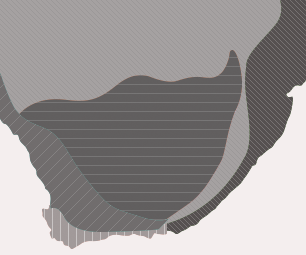Aloe striata subsp. karasbergensis
Aloe striata Haw. subsp. karasbergensis (Pillans) Glen & D.S.Hardy
Family: Asphodelaceae
Common names: Karasberg aloe (Eng.); Karasbergaalwyn (Afr.)
Introduction
Aloe striata subsp. karasbergensis is one of two less known, but equally striking, subspecies of Aloe striata. This particular subspecies is well known for its attractive rusty brown to bronze, leaf colour, as well as beautiful and charismatic symmetrical leaf crowns.

Description
Description
Aloe striata subsp. karasbergensis is a low-growing, single to branched, stemmed plant, which tends to lie horizontally on the ground as the plant gets older. Stems may reach a height of 300 mm, with old leaves that persist around the stem. In old specimens, branching of the main stem close to the ground level, may give rise to up to 15–20 heads. The leaves are ovate-lanceolate, 400–500 × 150–200 mm and very rigid to fleshy when turgid. The leaf colour varies from a pale green-grey to bronze and brown with a pinkish tinge, under sun-stressed conditions. Leaves are carried in beautifully symmetric rosettes and have prominent longitudinal, dark green lines on their surface.

The flowers which appear from January to March, are carried on densely branched racemes of up to 500 mm high. The flowers are tubular in shape with a slight basal swelling, and are a dull red colour.
Conservation Status
Status
Aloe striata subsp. karasbergensis is found in the Succulent Karoo and Nama Karoo Biomes of the Northern Cape, and is classified as LC (Least Concerned), and therefore, not threatened.
Distribution and habitat
Distribution description
Aloe striata subsp. karasbergensis is found in the Desert, Succulent Karoo and Nama Karoo Biomes of South Africa and Namibia. It occurs in the southern parts of Namibia around the Karas Mountain region and in the Gariep Valley of the Richtersveld. Further eastwards it occurs into the highlands of great Bushmanland. Plants have a preference for dry, hot desert to semi-desert conditions, and may be found in dry river beds, rocky hill slopes, and stony rugged mountainous areas, where they are sheltered among boulders and rock massifs.

Derivation of name and historical aspects
History
The genus name Aloe is derived from the Arabic, Alloch and translated as Allal in Greek and Hebrew, literally meaning ‘bitter’ or ‘bitter sap’, which is descriptive of aloe sap. The specific epithet striata literally means ‘marked with lines’, a conspicuous characteristic seen on the leaves of all three subspecies. The subspecies name karasbergensis, refers to the great Karasberg Mountains in the south of Namibia, one of the places where it occurs. The plant was collected in October 1926 by well-known plant collector and botanical explorer, Neville Stuart Pillans (1884–1964) from Rosebank, Cape Town. Pillans decribed the plant when it flowered in his Rosebank garden in February 1928.
Ecology
Ecology
The flower bases of Aloe striata subsp. karasbergensis contain nectarines that produce nectar, which are offered as a reward to pollinators, such as sugar birds and winged and crawling insects. After fertilization, the fruits, which are capsules, grow quickly and split into three parts in late summer to autumn, to release the wind-dispersed seeds. The plant in itself, is very tough, and can survive often for several seasons without water, at which point the leaves turn a reddish colour to protect the plant against the high intensity ultra violet sun rays, much in the same way as sun block on the human skin. The leaves also close inwardly to protect the young leaves from heat stress.
Uses
Use
No medicinal uses are recorded for Aloe striata subsp. karasbergensis. There is no doubt that this subspecies would make very attractive plants for arid gardens and containers. The species grows well in cultivation and will even tolerate fairly high rainfall conditions, making it an adaptable species to a variety of environments.
Growing Aloe striata subsp. karasbergensis
Grow
Aloe striata subsp. karasbergensis grows best from freshly harvested seeds, but care must be taken to avoid over watering. Too much shade leads to ideal conditions for fungal and viral infections, as well as root rot. Once established, plants grow relatively fast in well-drained soils with ample sunlight. Companion plants include Aloe falcata, A. khamiesensis, A. melanacantha, A. microstigma subsp. microstigma, A. striata subsp. kommagasensis and A. striata subsp. striata. Other additions to consider are Lampranthus aureus, L. multiradiatus and L. reptans, Pelargonium crithmifolium, P. echinatum, P. sericifolium, P. spinosum and P. xerophtyon, Stoeberia arborea, Gazania krebsiana, Hermannia saccifera, Oscularia deltoides, Drosanthemum bicolor and Ruschia maxima, etc.
References
- Carter, S., Lavranos, J.J., Newton, L.E. &Walker, C.C. 2011.Aloes The Definitive Guide. Royal Botanic Gardens Kew, Richmond.
- Court, D. 1981. Succulent flora of southern Africa. Balkema, Cape Town.
- Germishuizen, G. & Meyer, N.L. (eds) 2003. Plants of southern Africa: an annotated checklist. Strelitzia 14. National Botanical Institute, Pretoria.
- Leistner, O.A. 2005. Seed plants of southern tropical Africa: families and genera. Southern African Botanical Diversity Network Report No. 26. SABONET, Pretoria
- Reynolds, G.W. 1950. The aloes of South Africa. Trustees of the Aloes of South Africa Book Fund, Johannesburg.
- Stearn, William T. 2003. Stearn’s Dictionary of plant names for the gardener. Cassel, UK.
- Smith, C.A. 1966. Common names of South African plants. Memoirs of the Botanical Survey of South Africa No. 35. Government Printer, Pretoria.
- Smith, G.F. & Van Wyk, B. 2008. Aloes in southern Africa. Struik, Cape Town.
- Van Wyk, B-E. & Smith, G. 1996. Guide to aloes of South Africa. Briza Publications, Pretoria.an
Credits
Werner Voigt
Karoo Desert NBG
March 2015
Plant Attributes:
Plant Type: Succulent
SA Distribution: Northern Cape
Soil type: Sandy, Clay
Flowering season: Early Summer, Late Summer
PH: Alkaline, Neutral
Flower colour: Red
Aspect: Full Sun
Gardening skill: Average
Special Features:
Horticultural zones









Rate this article
Article well written and informative
Rate this plant
Is this an interesting plant?
Login to add your Comment
Back to topNot registered yet? Click here to register.